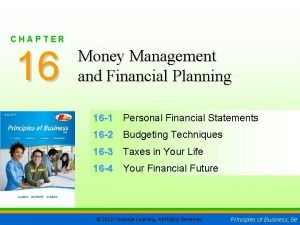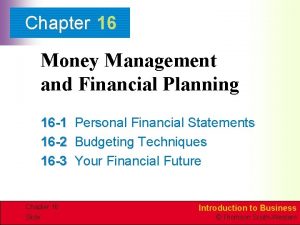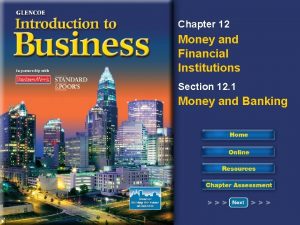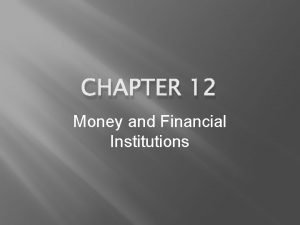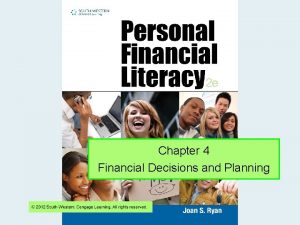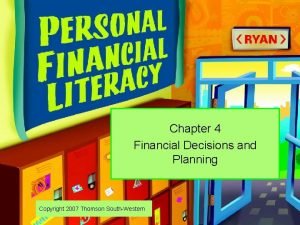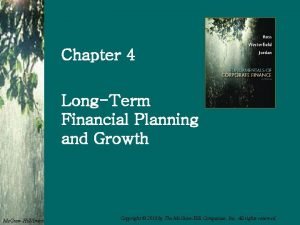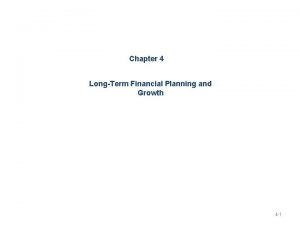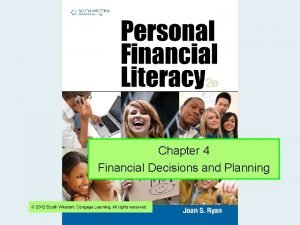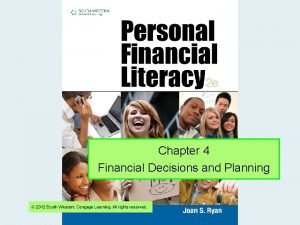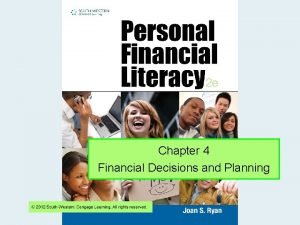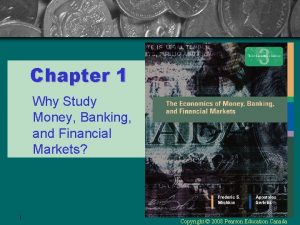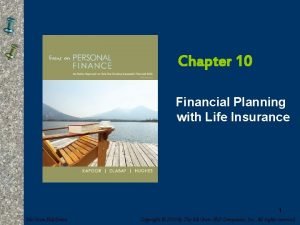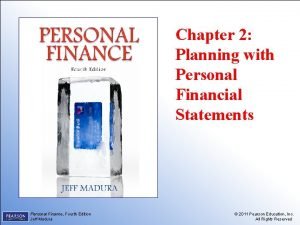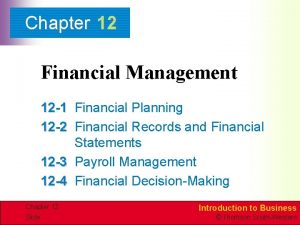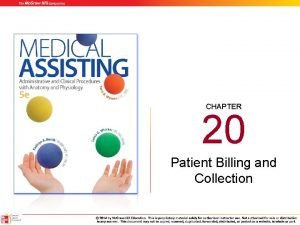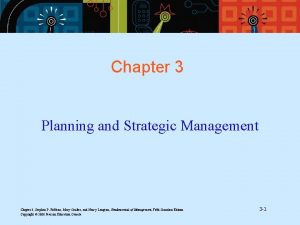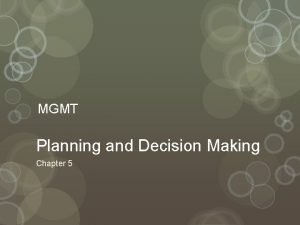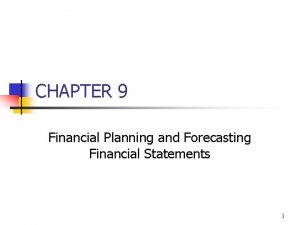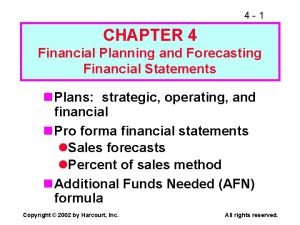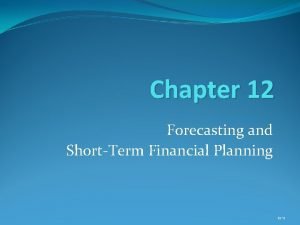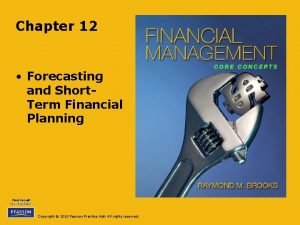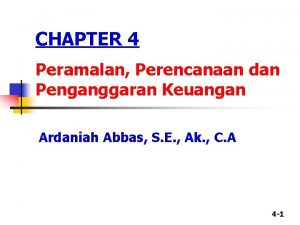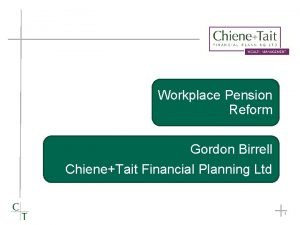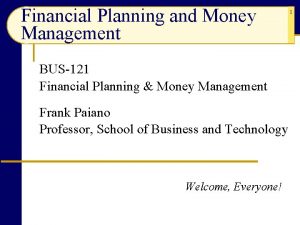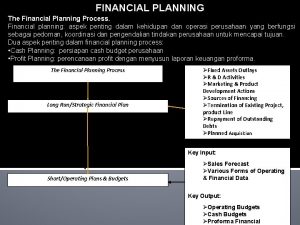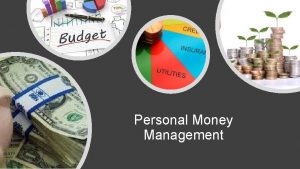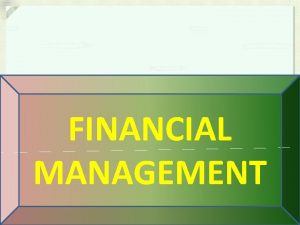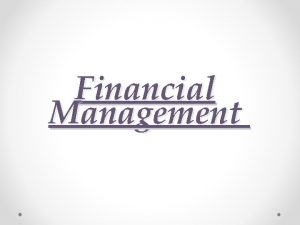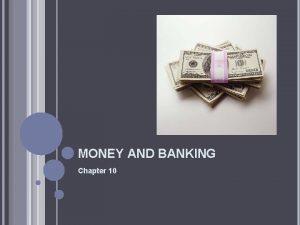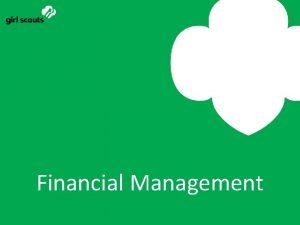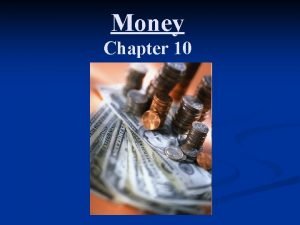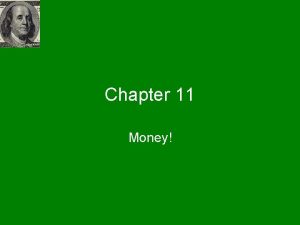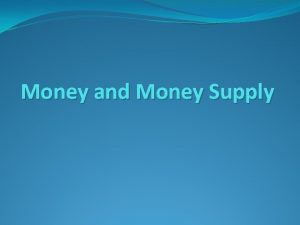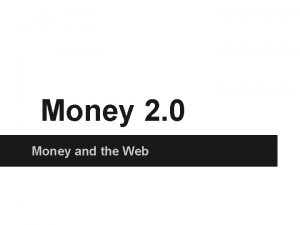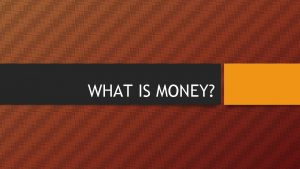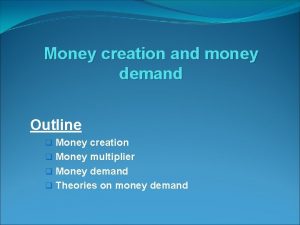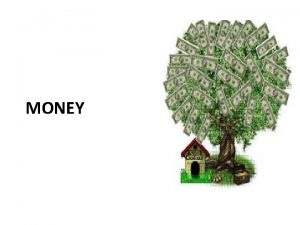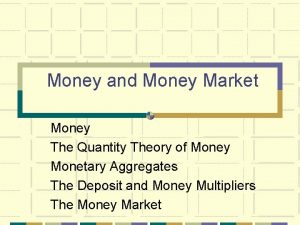Chapter 16 Money Management and Financial Planning 16




































- Slides: 36

Chapter 16 Money Management and Financial Planning 16 -1 Personal Financial Statements 16 -2 Budgeting Techniques 16 -3 Your Financial Future Chapter 16 Slide Introduction to Business © Thomson South-Western

LESSON 16 -1 Personal Financial Statements Goals n Explain the basics of money management. n Create a personal balance sheet. n Develop a personal cash flow statement. Chapter 16 2 Introduction to Business © Thomson South-Western

Key Terms n money management n personal assets n net worth n cash flow statement Chapter 16 3 Introduction to Business © Thomson South-Western

MONEY MANAGEMENT BASICS n Refers to the day-to-day financial activities associated with using limited income to satisfy your unlimited needs and wants n Involves getting the most for your money through careful planning, saving, and spending n Involves making and using a plan for spending Chapter 16 4 Introduction to Business © Thomson South-Western

SUCCESSFUL MONEY MANAGERS n Set goals n Make wise decisions n Buy wisely n Live within their income Chapter 16 5 Introduction to Business © Thomson South-Western

>> C H E C K P O I N T What are some characteristics of a wise money manager? Chapter 16 6 Introduction to Business © Thomson South-Western

PERSONAL BALANCE SHEET n Assets n Liabilities n Net Worth Chapter 16 7 Introduction to Business © Thomson South-Western

SAMPLE PERSONAL BALANCE SHEET Chapter 16 8 Introduction to Business © Thomson South-Western

>> C H E C K P O I N T What are three main categories of a personal balance sheet? Chapter 16 9 Introduction to Business © Thomson South-Western

PERSONAL CASH FLOW STATEMENT n Cash inflows n Cash outflows n Compare inflows and outflows Chapter 16 10 Introduction to Business © Thomson South-Western

SAMPLE PERSONAL CASH FLOW STATEMENT Chapter 16 11 Introduction to Business © Thomson South-Western

>> C H E C K P O I N T What do cash outflows represent? Chapter 16 12 Introduction to Business © Thomson South-Western

LESSON 16 -2 Budgeting Techniques Goals n Identify purposes of a budget. n Describe steps for preparing a budget. n Describe characteristics of successful budgeting. Chapter 16 13 Introduction to Business © Thomson South-Western

Key Terms n fixed expenses n variable expenses n allowance n budget variance Chapter 16 14 Introduction to Business © Thomson South-Western

BUDGET ACTIVITIES n Live within your income n Achieve your financial goals n Buy wisely n Avoid credit problems n Plan for financial emergencies n Develop good money management skills Chapter 16 15 Introduction to Business © Thomson South-Western

>> C H E C K P O I N T What are the main purposes of a budget? Chapter 16 16 Introduction to Business © Thomson South-Western

THE BUDGET PROCESS n n Set financial goals Plan budget categories Maintain financial records Evaluate your budget Chapter 16 17 BUDGET CATEGORIES n Savings n Food n Clothing n Household n Transportation n Health and personal care n Recreation and education n Gifts and contributions Introduction to Business © Thomson South-Western

SAMPLE FAMILY BUDGET Chapter 16 18 Introduction to Business © Thomson South-Western

>> C H E C K P O I N T What are eight commonly used budget categories? Chapter 16 19 Introduction to Business © Thomson South-Western

CHARACTERISTICS OF AN EFFECTIVE BUDGET n Must be realistic n Should be flexible n Should be evaluated regularly n Must be well planned and clearly communicated n Should have a simple format Chapter 16 20 Introduction to Business © Thomson South-Western

BUDGETING FORMATS n Software program n Handwritten n Checkbook n Unwritten Chapter 16 21 Introduction to Business © Thomson South-Western

SAMPLE INCOME AND EXPENSE RECORD Chapter 16 22 Introduction to Business © Thomson South-Western

>> C H E C K P O I N T What are five characteristics of an effective budget? Chapter 16 23 Introduction to Business © Thomson South-Western

LESSON 16 -3 Your Financial Future Goals n Describe the financial planning process. n Explain actions for implementing a financial plan. n Identify actions for reviewing a financial plan. Chapter 16 24 Introduction to Business © Thomson South-Western

Key Terms n financial plan n individual retirement account (IRA) n estate planning Chapter 16 25 Introduction to Business © Thomson South-Western

ADVANTAGES OF FINANCIAL PLANNING n Your financial uncertainties will be reduced. n You will gain more control of your financial activities. n Your family and household members will know more in case they need to assume control of your finances. n Earning, spending, protecting, and saving your resources will be more systematic. Chapter 16 26 Introduction to Business © Thomson South-Western

FINANCIAL PLANNING PROCESS 1. Analyze your current financial condition 2. Develop financial goals that are responsive to your vision 3. Create your financial plan 4. Implement the plan 5. Revise your financial plan Chapter 16 27 Introduction to Business © Thomson South-Western

FINANCIAL INVENTORY n n Careful review of your finances Personal balance sheet Personal cash flow statement Information about current financial position n n Income Savings Investments Property Chapter 16 28 n Living expenses n Insurance n Money owed Introduction to Business © Thomson South-Western

PERSONAL FINANCIAL FILING SYSTEM n n n n Personal records Housing records Consumer purchase records Insurance records Money management records Tax records Financial services and credit records Investment, retirement, and estate records Chapter 16 29 Introduction to Business © Thomson South-Western

FINANCIAL LIFE CYCLE n Teen years n Twenties n Later n Retirement Chapter 16 30 Introduction to Business © Thomson South-Western

USING A FINANCIAL PLANNER n Questions you might ask when choosing a financial planner n What experience and training do you have? n Are you willing to supply references from past clients? n How are your fees determined? Chapter 16 31 Introduction to Business © Thomson South-Western

>> C H E C K P O I N T List five recommended steps for financial planning. Chapter 16 32 Introduction to Business © Thomson South-Western

IMPLEMENT A FINANCIAL PLAN n Insure current income n Disability income insurance n Unemployment insurance n Plan for future income n n Social Security Pensions Retirement accounts Annuities Chapter 16 33 Introduction to Business © Thomson South-Western

>> C H E C K P O I N T What are common sources of income during retirement? Chapter 16 34 Introduction to Business © Thomson South-Western

REVIEW YOUR FINANCIAL PLAN n Revise financial goals n Review financial activities n Remember to save Chapter 16 35 Introduction to Business © Thomson South-Western

>> C H E C K P O I N T What common activities are needed when reviewing a financial plan? Chapter 16 36 Introduction to Business © Thomson South-Western
 Chapter 16 money management and financial planning
Chapter 16 money management and financial planning Chapter 16 money management and financial planning
Chapter 16 money management and financial planning Money money money team
Money money money team Chapter 12 money and financial institutions
Chapter 12 money and financial institutions Chapter 12 money and financial institutions
Chapter 12 money and financial institutions Chapter 4 financial decisions and planning
Chapter 4 financial decisions and planning Chapter 4 financial decisions and planning
Chapter 4 financial decisions and planning Long term financial planning and growth chapter 4
Long term financial planning and growth chapter 4 Long-term financial planning and growth
Long-term financial planning and growth Chapter 4 financial decisions and planning
Chapter 4 financial decisions and planning Chapter 4 financial decisions and planning
Chapter 4 financial decisions and planning Chapter 4 financial decisions and planning
Chapter 4 financial decisions and planning Symbolism of the green light in great gatsby
Symbolism of the green light in great gatsby Money smart money match
Money smart money match Money on money multiple
Money on money multiple Gatsby historical background
Gatsby historical background Tom buchanan character traits
Tom buchanan character traits Why study money banking and financial markets
Why study money banking and financial markets Why study money banking and financial markets
Why study money banking and financial markets Chapter 10 financial planning with life insurance
Chapter 10 financial planning with life insurance Chapter 2 personal financial planning answers
Chapter 2 personal financial planning answers Chapter 12 financial management
Chapter 12 financial management Financial management chapter 8 risk and return
Financial management chapter 8 risk and return The process of classifying and reviewing past due accounts
The process of classifying and reviewing past due accounts Crown ministries budget
Crown ministries budget Financial methods of motivation definition
Financial methods of motivation definition Management chapter 5 planning and decision making
Management chapter 5 planning and decision making Chapter 3 planning
Chapter 3 planning Management chapter 5 planning and decision making
Management chapter 5 planning and decision making Financial planning and forecasting
Financial planning and forecasting Financial planning and forecasting
Financial planning and forecasting Objectives of financial planning and forecasting
Objectives of financial planning and forecasting Financial planning and forecasting problems with solutions
Financial planning and forecasting problems with solutions Financial analysis planning and forecasting
Financial analysis planning and forecasting Budgeting forecasting and planning
Budgeting forecasting and planning Short term financial management
Short term financial management Least workplace
Least workplace
